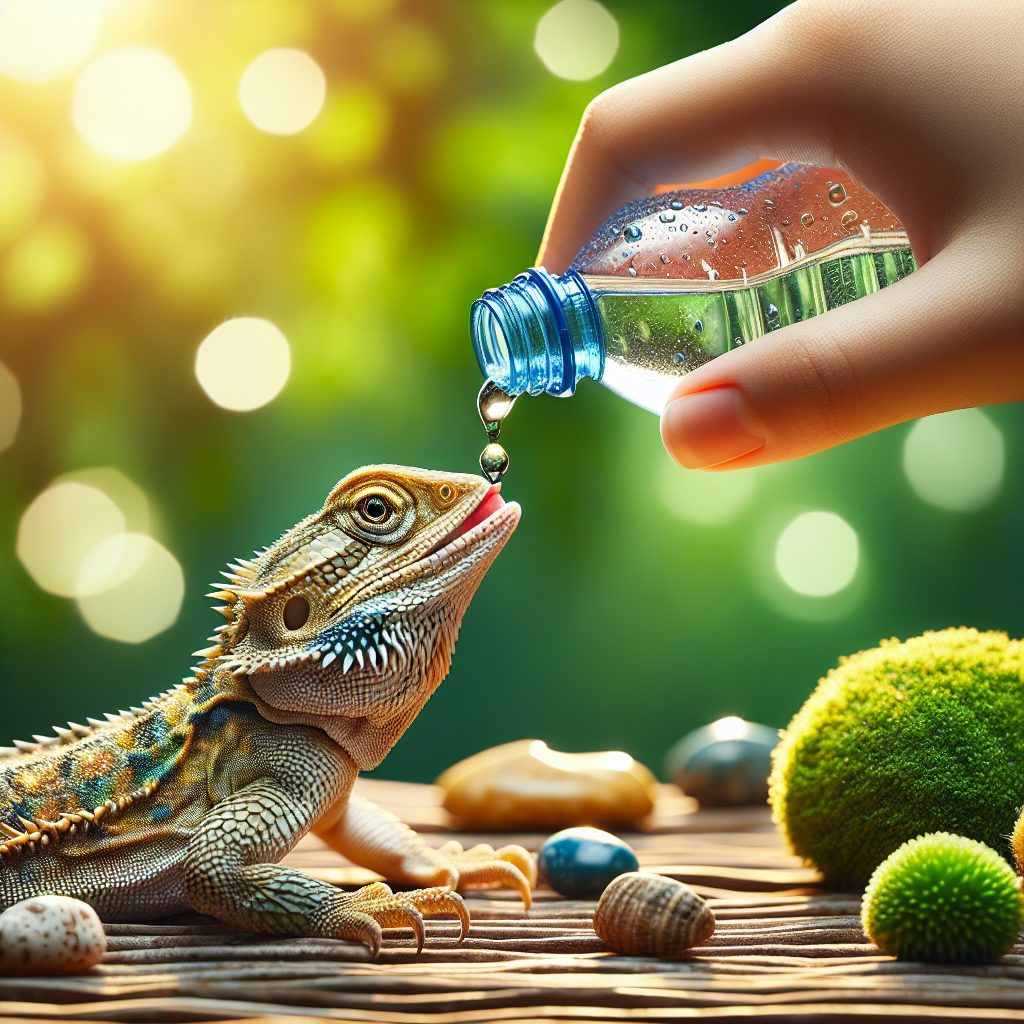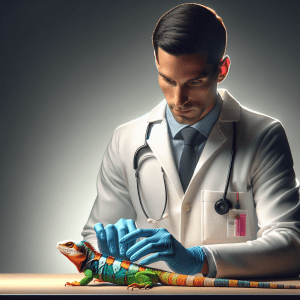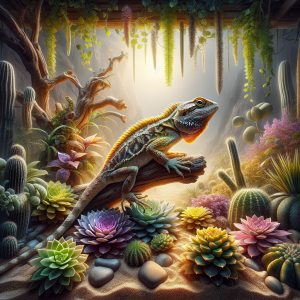Introduction: Importance of Hydration for Pet Lizards
You might not realize it, but ensuring proper hydration for your pet lizards is crucial. Just like us, lizards need water to stay healthy and thrive. Picture this: a lizard basking under a warm light, its tiny tongue darting out to sip water droplets. It’s a mesmerizing sight, isn’t it?
Now, let’s delve into why hydration is so important for these fascinating creatures. Did you know that lizards absorb water not only by drinking but also through their skin? It’s a unique aspect of their biology that highlights the intricacies of caring for these reptiles.
Let me share a practical tip with you: when setting up a hydration station for your pet lizard, make sure to provide a shallow water dish that is easily accessible. This simple act can make a world of difference in ensuring that your lizard stays hydrated and healthy.
As an expert in all things lizard-related, I’ve seen firsthand how proper hydration can impact the overall well-being of these incredible creatures. It’s not just about quenching their thirst; it’s about supporting their physiological functions and promoting a vibrant, active lifestyle.
So, the next time you observe your pet lizard taking a sip of water, remember the importance of hydration in their daily lives. By prioritizing their hydration needs, you’re not just caring for a pet – you’re fostering a thriving and happy companion.
Understanding the Hydration Needs of Pet Lizards
Understanding the hydration needs of your pet lizards is crucial for their well-being. You see, just like us, these scaly companions require proper hydration to stay healthy and vibrant. Imagine a hot desert day without a sip of water – not a pleasant thought, right? Well, it’s the same for your pet lizard. They rely on you to provide them with the necessary hydration to thrive.
Now, let me share a fascinating fact with you. Did you know that pet lizards absorb water not only by drinking but also through their skin? It’s true! This unique ability makes it even more essential to ensure they have access to appropriate water sources. Picture your lizard basking under a heat lamp, their skin absorbing moisture – it’s a beautiful and natural process that keeps them hydrated.
So, when considering the hydration needs of your pet lizard, think beyond just offering a water bowl. Consider creating a hydration station within their enclosure that mimics their natural habitat. By incorporating live plants or a mister, you can provide a humid environment that supports their hydration requirements. This simple yet effective tip can make a significant difference in your pet lizard’s health and happiness.
Remember, understanding how to hydrate your pet lizard is a fundamental aspect of responsible lizard ownership. By taking the time to learn about their hydration needs and implementing proper techniques, you’re not just a pet owner – you’re a lizard hydration hero!
Types of Water Sources for Pet Lizards
When it comes to providing hydration for your pet lizards, the types of water sources you choose can make a big difference in their overall health and well-being. Imagine a scenario where you offer your lizard tap water, only to realize that it’s not the best choice for their hydration needs. This personal anecdote highlights the importance of selecting the right water sources for your reptile companions.
Did you know that pet lizards can be quite picky when it comes to the water they drink? Some species may prefer still water, while others might enjoy a gentle misting from a spray bottle. Understanding the specific preferences of your pet lizard can help you cater to their hydration needs more effectively. By offering a variety of water sources, you can ensure that your lizard stays properly hydrated and healthy.
Experimenting with different hydration methods can be a fun way to bond with your pet lizard and learn more about their individual preferences. From water dishes to drippers to misting systems, there are plenty of options to explore. By observing how your lizard interacts with different water sources, you can tailor their hydration routine to suit their unique needs.
So, the next time you’re setting up a hydration station for your pet lizard, consider trying out a few different water sources to see which one they prefer. Your lizard will thank you for it with their happy, hydrated demeanor!
Best Practices for Hydrating Pet Lizards
Understanding the importance of hydration for your pet lizard is crucial. Imagine yourself in the scorching desert, desperate for a drink. That’s how your lizard feels when it’s dehydrated. You wouldn’t want your scaly friend to experience that discomfort, right? Providing your pet lizard with access to fresh water is essential for their well-being. Just like us, lizards need water to survive and thrive. Now, let me share a fascinating fact with you. Did you know that some lizard species can absorb water through their skin? That’s pretty cool, isn’t it? When setting up a hydration station in your lizard’s enclosure, make sure to place the water dish in a spot where it won’t get contaminated with substrate or feces. It’s like having a clean glass of water for yourself – hygiene matters! Remember, monitoring your pet lizard’s hydration levels is key. Keep an eye out for signs of dehydration, such as sunken eyes or lethargy. If you notice any of these symptoms, it’s time to take action. So, tell me, have you ever witnessed your lizard drinking water? It’s quite a sight to behold! Providing proper hydration for your pet lizard not only keeps them healthy but also strengthens your bond with your scaly companion.
Creating a Hydration Station in Your Lizard’s Enclosure
Water is essential for all living beings, including our scaly friends. When it comes to hydrating your pet lizard, it’s crucial to create a designated hydration station within their enclosure. Picture this: a mini oasis in the desert, but for your lizard buddy.
To set up this hydration paradise, opt for a shallow dish filled with fresh water. Lizards have different preferences, so some may prefer a water bowl, while others might enjoy a misting system. It’s like choosing between a pool or a refreshing shower on a hot day!
Monitoring your lizard’s hydration levels is key. Keep an eye on how much water they consume and their skin’s elasticity. Remember, a well-hydrated lizard is a happy lizard! It’s like ensuring your best friend has their favorite drink on hand at all times.
Now, here’s a fun fact: did you know that some lizard species absorb water through their skin? It’s like having a built-in hydration system! So, providing a moist substrate can also help keep your scaly pal hydrated and healthy.
As you navigate the world of lizard hydration, always aim to provide a variety of hydration methods to cater to your pet’s individual needs. With the right setup and a little observation, you can ensure that your lizard stays hydrated and thriving in their cozy habitat.
Monitoring Hydration Levels in Pet Lizards
Have you ever wondered how to effectively monitor the hydration levels of your pet lizard? Keeping an eye on your scaly friend’s water intake is crucial for their well-being. Imagine this: you observe your lizard basking under the heat lamp, and you notice they haven’t touched their water dish in a while. This could be a red flag indicating potential dehydration. To avoid such situations, consider implementing a simple yet effective monitoring system. One practical tip is to keep track of how much water your lizard typically consumes daily. By establishing a baseline, you can easily detect any deviations in their drinking habits. Another strategy is to observe your lizard’s behavior – are they lethargic or overly active? Changes in behavior could signal hydration issues. Remember, prevention is key when it comes to keeping your pet lizard healthy and hydrated. So, why not take a proactive approach and start monitoring your lizard’s hydration levels today? By staying vigilant and attentive to your lizard’s water intake, you can ensure they remain happy and hydrated for years to come.
Signs of Dehydration in Pet Lizards
Dehydration in pet lizards can sometimes be tricky to spot, but it’s crucial to know the signs. One day, while checking on my bearded dragon, I noticed he seemed lethargic and his skin looked wrinkled. I immediately knew something was wrong and suspected dehydration. It’s essential to keep a close eye on your lizard’s hydration levels because, like us, they can suffer from dehydration. Apart from physical symptoms like sunken eyes or wrinkled skin, behavioral changes such as reduced activity or loss of appetite can also indicate dehydration. Remember, prevention is key when it comes to keeping your pet lizard healthy and hydrated. Regularly monitoring their water intake and ensuring they have access to fresh water sources is vital for their well-being. By staying proactive and observant, you can help your pet lizard stay hydrated and happy. So, next time you interact with your scaly friend, pay attention to any unusual behavior or physical changes that could signal dehydration. Your attentive care can make all the difference in ensuring your pet lizard’s health and happiness.
Hydration Mistakes to Avoid with Pet Lizards
Picture this: you’re all set to be the best lizard parent ever, but you make a critical mistake – you’re overhydrating your scaly friend. Yes, you read that right. Too much water can be just as bad as too little for your precious pet. It’s a hydration conundrum, but fear not, I’m here to guide you through the muddy waters of lizard hydration.
Here’s the deal: overhydration can lead to a host of issues, from skin problems to respiratory distress. It’s like trying to quench your thirst with a firehose – not exactly ideal. So, how do you strike the perfect balance? Well, it’s all about observation and moderation. Keep an eye on your lizard’s behavior and adjust their hydration levels accordingly. Think of yourself as a hydration detective, cracking the case of the perfect water balance for your scaly buddy.
Now, I know what you’re thinking – how do I even know if my lizard is getting too much water? Look out for signs like bloating, lethargy, or even difficulty breathing. If your lizard starts resembling a water balloon, it might be time to dial back on the hydration efforts. Remember, it’s all about finding that sweet spot where your lizard stays happy and healthy.
So, the next time you reach for the water bowl, remember the golden rule: moderation is key. Your lizard will thank you for it, and you’ll be well on your way to hydration hero status.
Hydration Tips for Specific Lizard Species
Are you curious about hydration tips for specific lizard species? Let’s dive into this fascinating topic together!
When it comes to ensuring your pet lizard stays hydrated, understanding the specific needs of different lizard species is crucial. Each species has its own hydration requirements, so tailoring your hydration methods accordingly is key.
Let me share a personal anecdote with you – I once had a bearded dragon who was quite picky about his water source. He preferred drinking water droplets off leaves rather than from a dish. Understanding his preference helped me ensure he stayed properly hydrated.
Did you know that some lizard species, like the Green Anole, prefer to drink water droplets off plants rather than from a water dish? This unique behavior showcases the diverse hydration preferences across different lizard species.
When caring for specific lizard species, it’s essential to research their natural habitats and behaviors. By replicating their natural environment as closely as possible, you can encourage natural hydration behaviors in your pet lizard.
Have you ever wondered why certain lizard species prefer specific hydration methods over others? Understanding the evolutionary adaptations of different lizard species sheds light on their hydration preferences.
By tailoring your hydration methods to suit the specific needs of your pet lizard’s species, you can ensure they stay healthy and hydrated. Remember, a well-hydrated lizard is a happy lizard!
Conclusion: Ensuring Optimal Hydration for Your Pet Lizard
Have you ever wondered about the intricate world of hydration methods for pet lizards? As a seasoned expert in this field, I can assure you that ensuring your scaly companions stay properly hydrated is crucial for their health and well-being.
Let me share a fascinating fact with you – did you know that different lizard species have varying hydration requirements? It’s true! Each type of lizard may have specific needs when it comes to staying hydrated, which makes understanding their individual preferences essential.
Now, let’s delve into a practical tip that can make a significant difference in keeping your pet lizard hydrated. When setting up a hydration station in your lizard’s enclosure, consider using a combination of water dishes, misters, and live plants to provide a variety of hydration options. This approach can mimic their natural habitat and encourage them to drink more frequently.
Monitoring your pet lizard’s hydration levels is also crucial. Keep an eye out for signs of dehydration, such as sunken eyes or lethargic behavior. By staying vigilant and proactive, you can address any hydration issues promptly and ensure your lizard stays healthy and happy.
So, whether you’re a seasoned reptile enthusiast or a novice lizard owner, understanding the best hydration methods for your pet lizard is essential. With the right knowledge and approach, you can create a thriving environment that supports your lizard’s hydration needs.




